|
 THE
ORIGINS BETWEEN MYTH AND REALITY THE
ORIGINS BETWEEN MYTH AND REALITY
Our beautiful city of Naples is so rich in history that Stendhal thought it was
the only place (together with Paris) that might claim to be the "capital"
of Europe. Between myth and reality, Naples is now 3,000 years old, going
back to the days and events of the numerous peoples who dwelled in the chief
town of what is now the Campania region of Italy. In the area of Materdei
there is a prehistoric necropolis dating back to the 3rd century B.C. as
well as a settlement from the 19th century B.C. It is commonly held that
Naples was founded by ancient Cumans in the 7th century B.C. The Cumans
named it Parthenope (virgin), the name of the mythological siren.
Legend says that after failing to enchant Ulysses, she and her sister sirens
killed themselves, and the waves brought the body of Parthenope to the spot
where the Cumans then founded the first Neapolitan nucleus. The area covered
the island of Megaride (site, today, of the famous Castel dell'Ovo) and
Mount Echia, better known as the Pizzofalcone Hill. This small nucleus later
declined in importance when the Etruscans destroyed Cuma in the year 524
B.C. Only later, in 474, did the Greeks from Siracusa, allied with the Cumans,
defeat the Etruscans and found a new town, Neapolis (new town), which, with
the ancient Partenope, by then called simply Palepoli (old town), formed
a single "polis." |
|
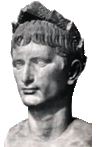 The
6th- 3rd century B.C. through to the 5th century A.D. THE DOMINION OF
ROME The
6th- 3rd century B.C. through to the 5th century A.D. THE DOMINION OF
ROME
Neapolis and the region of Campania is dominated by the Romans from the
time of the three Samnite wars all the way to the fall of the Roman Empire.
Naples is conquered in the year 326 B.C. Governed by the Romans, the city
is never completely Romanised, preserving local speech, including Greek
elements that still exist in the Neapoletan dialect. In the year 268 B.C.
The Roman Empire founds Beneventum and, in the year 1 A.D. Puteolis becomes
modern Pozzuoli with the port containing one of the most important grain
supplies in Europe. Naples develops differently a bit more slowly, but
immediately becomes a centre for tourism as wealthy Romans begin to build
their holiday villas at Posillipo, Bacoli, Cuma and Baia. In the meantime,
Emperor Augustus founds at Cape Misenum the base for the Imperial
fleet in the Tirrenean. The catacombs of S. Gennaro show the arrival of
the first Christian communities in the first years A.D. This first century
is sadly remembered for the eruption of Vesuvius, which in the year 79
A.D. destroyed two modern towns (Pompei and Herculanium), covering them
in lava and ash. In the 2nd century A.D. Emperor Traianus orders the extension
of the via Appia to Brindisi and the construction of the Arch of Triumph
in Benevento.
|
The 6th
- 8th century A.D. The Lombards and Byzantines
The last emperor of the western Roman Empire is Romulus Augustulus. After
his death in Naples, the region becomes a Lombard holding, while Naples,
itself, is conquered by Belisarius and passes in 536 A.D. to the dominion
of Byzantium. It becomes part of the duchy of Byzantium, and in 763 a self-
governing duchy. |
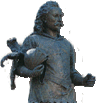 The
11th century. The Normans. The
11th century. The Normans.
In 1030, Norman Rainulfo Drengot founds the cathedral of Aversa setting
the stage for future Norman conquest. Then, in 1139, Naples falls under
Roger of Hauteville, who becomes the first historical King of Naples.
Naples now takes on a secondary role , leaving Palermo as the capital of
the Kingdom of the Two Sicilies. In 1194, Swabians conquer the city of Naples.
In 1214, Frederick II of Swabia founds the University of Naples, which had
such illustrious lecturers as Thomas Aquinas and Giambattista Vico. |
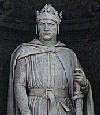 The
12th century. The Angevins The
12th century. The Angevins
In 1266 Charles of Anjou defeats Manfred near Benevento. Two years
later in 1268, after the execution of Conradin of Swabia, in Piazza Mercato,
Naples passes to the French Angevins, who not only governed for two centuries,
but moved Naples back into the role of capital of the kingdom. Under Charles
I, from an architectural point of view, there is a development towards the
Gothic, and the king celebrates his dynasty and victories through French
works. Under Roberto of Anjou, Naples becomes a large artistic and cultural
center thanks to the presence of artists and intellectuals such as Simone
Martini, Lello da Orvieto, Giotto, Petrarch and Boccaccio.The frescoes and
tombs in the church of S. Giovanni a Carbonara are from the 15th century.
|
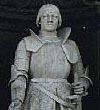 The
15th century. The Aragonese. The
15th century. The Aragonese.
In 1442 Alphonse of Aragon becomes king of Naples. Naples becomes
a leading center of art and culture. Examples may be seen at the Castel
Nuovo with the triumphal arch over the entrance sculpted by craftsmen from
all quarters of the kingdom. During the reign of Charles III, the Aragonese
dynasty cedes power to the French, who, in turn cede to the Spanish. |
The16th
century THE SPANISH
In 1503, under Consalvo di Cordoba, Naples becomes a vicerealm within the
Spanish Empire. In 1532 with the arival of Pedro da Toledo, Naples is expanded
and undegoes cultural and urban renewal: Via Toledo is built and the "Spanish
quarters" are born. The city is now an important center, enticing the nobility
to leave their country estates in favor of life in the city. The population
grows to 200,000. Sculpture in this period is extraordinary, with such artists
as Giovanni di Nola, Girolamo S.Croce , Pietro Bernini and many more. In
1538, after a number of terrible earthquakes, a new mountain, Monte Nuovo,
rises in the Flegrean fields. |
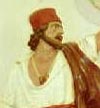 The
17th century The
17th century
In this century, a fisherman named Masaniello organizes and leads
a rebellion against the Spanish. The riot is immediately quelled with the
execution of the rebels and leader in Piazza Mercato. Other main features
of this century are the spread of the plague, causing the decimation of
the population; also, in 1688, the territory is struck by a terrible earthquake,
inflicting great damage to the architectural and artistic heritage. |
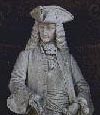 The
18th century THE AUSTRIANS AND THE PARTENOPEAN REPUBBLIC The
18th century THE AUSTRIANS AND THE PARTENOPEAN REPUBBLIC
Spanish rule is replaced by that of Austria, which will govern the city
for a mere 27 years. Then, in 1734, the city becomes the capital of the
kingdom of the Bourbons under King Charles III. Once he returns to
Spain, the throne passes to King Ferdinand IV, who continues great building
projects such as the Reggia di Caserta; he also founds the Royal Military
Accademy Nunziatella, and the Royal Silk Factory of San Leucio, where even
today one can admire the splendid silks produced at the time. In 1799, the
Parthenopean Repubblic is proclaimed. It will last six months and will be
remembered for its extreme violence on both sides. Immediately after the
fall of the Republic, King Ferdinand regains power. |
|
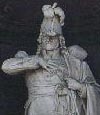 The
19th century. Annexation to the Kingdom of Italy The
19th century. Annexation to the Kingdom of Italy
In 1806 the Bourbon monarchy of Naples flees to Sicily as Joseph Bonaparte
takes over the rule of Naples in the name of his brother, Napoleon. Two
years later, Joseph is replaced by Gioacchino (Joachim) Murat,
who holds power until 1815, the year in which the Bourbons take power
for the third time. Ferdinand II of Bourbon inaugurates the first Italian
railway, connecting Naples and Portici; the first ferryboats serve the
port of Naples.In 1860 Garibaldi enters the city and declares it part
of the Kingdom of Italy. By the end of the century, Naples becomes one
of the most populous towns in Europe, with 450,000 inhabitants. This causes
dramatic problems of health and hygiene in the center of town and the
solution is found in the demolition of an entire quarter and the construction
of the broad avenue known as the "Rettifilo", Corso Umberto I.
| |
|

